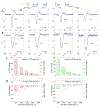Phase-Locked Stimulation during Cortical Beta Oscillations Produces Bidirectional Synaptic Plasticity in Awake Monkeys
- PMID: 30100342
- PMCID: PMC6108550
- DOI: 10.1016/j.cub.2018.07.009
Phase-Locked Stimulation during Cortical Beta Oscillations Produces Bidirectional Synaptic Plasticity in Awake Monkeys
Abstract
The functional role of cortical beta oscillations, if any, remains unresolved. During oscillations, the periodic fluctuation in excitability of entrained cells modulates transmission of neural impulses and periodically enhances synaptic interactions. The extent to which oscillatory episodes affect activity-dependent synaptic plasticity remains to be determined. In nonhuman primates, we delivered single-pulse electrical cortical stimulation to a "stimulated" site in sensorimotor cortex triggered on a specific phase of ongoing beta (12-25 Hz) field potential oscillations recorded at a separate "triggering" site. Corticocortical connectivity from the stimulated to the triggering site as well as to other (non-triggering) sites was assessed by cortically evoked potentials elicited by test stimuli to the stimulated site, delivered outside of oscillatory episodes. In separate experiments, connectivity was assessed by intracellular recordings of evoked excitatory postsynaptic potentials. The conditioning paradigm produced transient (1-2 s long) changes in connectivity between the stimulated and the triggering site that outlasted the duration of the oscillatory episodes. The direction of the plasticity effect depended on the phase from which stimulation was triggered: potentiation in depolarizing phases, depression in hyperpolarizing phases. Plasticity effects were also seen at non-triggering sites that exhibited oscillations synchronized with those at the triggering site. These findings indicate that cortical beta oscillations provide a spatial and temporal substrate for short-term, activity-dependent synaptic plasticity in primate neocortex and may help explain the role of oscillations in attention, learning, and cortical reorganization.
Keywords: beta oscillations; closed loop; cortical connectivity; cortical stimulation; nonhuman primates; synaptic plasticity.
Copyright © 2018 Elsevier Ltd. All rights reserved.
Figures






Comment in
-
Latent Connectivity: Neuronal Oscillations Can Be Leveraged for Transient Plasticity.Curr Biol. 2018 Aug 20;28(16):R879-R882. doi: 10.1016/j.cub.2018.06.073. Curr Biol. 2018. PMID: 30130509
Similar articles
-
Paired Stimulation for Spike-Timing-Dependent Plasticity in Primate Sensorimotor Cortex.J Neurosci. 2017 Feb 15;37(7):1935-1949. doi: 10.1523/JNEUROSCI.2046-16.2017. Epub 2017 Jan 16. J Neurosci. 2017. PMID: 28093479 Free PMC article.
-
Synchronization of neurons during local field potential oscillations in sensorimotor cortex of awake monkeys.J Neurophysiol. 1996 Dec;76(6):3968-82. doi: 10.1152/jn.1996.76.6.3968. J Neurophysiol. 1996. PMID: 8985893
-
Oscillatory activity in sensorimotor cortex of awake monkeys: synchronization of local field potentials and relation to behavior.J Neurophysiol. 1996 Dec;76(6):3949-67. doi: 10.1152/jn.1996.76.6.3949. J Neurophysiol. 1996. PMID: 8985892
-
Coherent oscillations and short-term plasticity in corticothalamic networks.Trends Neurosci. 1999 Aug;22(8):337-45. doi: 10.1016/s0166-2236(99)01407-1. Trends Neurosci. 1999. PMID: 10407416 Review.
-
Exploring the connections between basal ganglia and cortex revealed by transcranial magnetic stimulation, evoked potential and deep brain stimulation in dystonia.Eur J Paediatr Neurol. 2022 Jan;36:69-77. doi: 10.1016/j.ejpn.2021.12.004. Epub 2021 Dec 10. Eur J Paediatr Neurol. 2022. PMID: 34922163 Review.
Cited by
-
Real-time TMS-EEG for brain state-controlled research and precision treatment: a narrative review and guide.J Neural Eng. 2024 Nov 1;21(6):061001. doi: 10.1088/1741-2552/ad8a8e. J Neural Eng. 2024. PMID: 39442548 Free PMC article. Review.
-
Synchronization between frontal eye field and area V4 during free-gaze visual search.Zool Res. 2019 Sep 18;40(5):394-403. doi: 10.24272/j.issn.2095-8137.2019.055. Zool Res. 2019. PMID: 31393096 Free PMC article.
-
Voluntary Motor Command Release Coincides with Restricted Sensorimotor Beta Rhythm Phases.J Neurosci. 2022 Jul 20;42(29):5771-5781. doi: 10.1523/JNEUROSCI.1495-21.2022. Epub 2022 Jun 14. J Neurosci. 2022. PMID: 35701160 Free PMC article.
-
Paired Electrical Pulse Trains for Controlling Connectivity in Emotion-Related Brain Circuitry.IEEE Trans Neural Syst Rehabil Eng. 2020 Dec;28(12):2721-2730. doi: 10.1109/TNSRE.2020.3030714. Epub 2021 Jan 28. IEEE Trans Neural Syst Rehabil Eng. 2020. PMID: 33048668 Free PMC article.
-
Human hippocampal responses to network intracranial stimulation vary with theta phase.Elife. 2022 Dec 1;11:e78395. doi: 10.7554/eLife.78395. Elife. 2022. PMID: 36453717 Free PMC article.
References
-
- Uhlhaas PJ, Roux F, Rodriguez E, Rotarska-Jagiela A, and Singer W (2010). Neural synchrony and the development of cortical networks. Trends in cognitive sciences 14, 72–80. - PubMed
-
- Sanes JN, and Donoghue JP (2000). Plasticity and primary motor cortex. Annual review of neuroscience 23, 393–415. - PubMed
-
- Nudo R (2014). Plasticity of cerebral motor functions: implications for repair and rehabilitation. In Textbook of Neural Repair and Rehabilitation, 2e, Volume 1, Selzer ME, Clarke S, Cohen LG, Kwakkel G and Miller RH, eds. (Cambridge, UK: Cambridge University Press; ), pp. 99–113.
-
- Donoghue JP, Sanes JN, Hatsopoulos NG, and Gaal G (1998). Neural discharge and local field potential oscillations in primate motor cortex during voluntary movements. Journal of neurophysiology 79, 159–173. - PubMed
Publication types
MeSH terms
Grants and funding
LinkOut - more resources
Full Text Sources
Other Literature Sources

